
[Randyrob] is pretty serious about their beer. So serious, that he wanted to build a fully automated system for brewing. Dubbed the Halfluck Automated Brewing System, or HABS, it is actually his first micro controller project. You can follow along on the arduino forums to get a little more information, including the source code if you should want to build one of your own. There are a few videos on his youtube channel, but unfortunately, we didn’t notice any full tours of the entire thing.
Like some others we’ve seen, this one only handles the brewing aspect, not the fermenting stages. It would be interesting to see a system that handled it all. You could fairly easily get the machine to siphon it into a keg for final carbonation too.
















